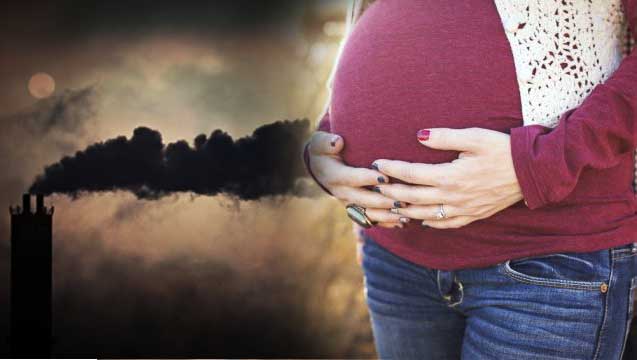Pregnant women with asthma may be at an increased risk for preterm births if they are exposed to high levels of air pollution from vehicles, according to new research. The study, published March 1 in the Journal of Allergy and Clinical Immunology, found that short-term and extended exposure to nitrogen oxides and carbon monoxide was associated with preterm deliveries, particularly when asthmatic women were exposed to those pollutants just before conception and in early pregnancy.
“Preterm birth is a major public health problem in this country – affecting more than 1 in 10 infants born in the United States,” Pauline Mendola, PhD, lead study author and an investigator at the National Institutes of Health’s (NIH) Eunice Shriver National Institute of Child Health and Human Development, said in an NIH news release. “Our study found that air pollution appears to add to the preterm birth risk faced by women with asthma,” Mendola added.
Asthma affects an estimated 9 percent of women of reproductive age in the U.S. While other studies have looked at the effects of air pollutants on preterm births, the research conducted by Mendola and her colleagues is the first to examine the ramifications of exposure before conception.
For the study, the researchers analyzed data from a sample of 223,502 singleton pregnancies delivered in 19 hospitals around the country from 2012 to 2018. Included in the information was the women’s asthma status and date of delivery.
The research team matched collected data with daily measures of air quality from the regions surrounding each of the hospitals to assess the potential impact of air pollution on preterm delivery. The researchers took into account such factors as location, age, race and ethnicity, pre-pregnancy weight, smoking and alcohol use, and chronic maternal health issues.
Findings showed that increased exposure to nitrogen oxide in the three months before pregnancy increased the risk of giving birth prematurely by 30 percent for women with asthma, compared to 8 percent for women who did not have the disease. Higher exposure to carbon monoxide during the same period raised the risk of preterm birth by 12 percent for women with asthma, but had no effect on women who were not asthmatic.
The research team also found that exposure to high levels of particulate matter air pollution – very small particles of substances such as acids, metals and dust in the air – in the last six weeks of pregnancy were linked to a higher risk of premature birth.
Mendola suggested one explanation for the link between air pollution and premature birth is that exposure to environmental pollutants may cause inflammation or other internal stresses that interfere with embryo implantation or placental development. Acknowledging that more research is needed, she advised women with asthma who are pregnant or trying to conceive to avoid exposure to air pollution whenever possible.
“There are already guidelines calling for people with asthma to avoid ambient exposure on bad air pollution days,” she told MedPage Today. “This may be especially important for women with asthma who are pregnant or trying to become pregnant.”
Exposure to air pollution during pregnancy ups the risk of ADHD in offspring
Pregnant women exposed to high levels of air pollution are at a greater risk of having children with behavior problems associated with attention deficit-hyperactivity disorder (ADHD), according to a new study. The study, published in the Nov. 5 online edition of PLOS ONE, is the first to explore the connection between air pollution and ADHD in school children over time.
Led by Frederica Perera, DrPH, PhD, director of the Center for Environmental Health Sciences at the Mailman School of Public Health at Columbia University, researchers zeroed in on the prenatal effects of air polluting compounds known as polycyclic aromatic hydrocarbons (PAH) on children. These compounds enter the air during the incomplete burning of coal, oil, gas, wood and other organic substances. Common sources of PAH include traffic, home heating furnaces, and coal-burning power plants.
Previous studies by Perera and her team linked prenatal PAH exposure to behavioral and mental problems, including developmental delays at age 3, reduced IQ at age 5, and symptoms of anxiety, depression and attention problems at ages 6 and 7. According to a Columbia University news release, the new study builds on these findings.
For the current study, the researchers followed 233 nonsmoking pregnant women from New York City and their children over a period of nine years. The scientists measured levels of the compounds in the newborn’s cord blood taken when the mother gave birth and the mother’s blood following delivery. They also analyzed urine samples from the children when they were 3 and 5 years old and measured levels of fragments of the mother’s DNA that bonded to PAH particles.
“That gives us a kind of fingerprint of individual exposure,” Perera told Live Science. “It shows how much was actually activated into an immediate toxic form that could damage DNA.”
Findings showed that children born to mothers with higher levels of PAH in their systems were five times more likely to show symptoms of ADHD at age 9 than those born to mothers with low levels of PAH. In addition, their symptoms – inattention, difficulty focusing on a task, inability to concentrate on what is being said, and lack of follow-through – are more intense.
“This study suggests that exposure to PAH encountered in New York City air may play a role in childhood ADHD,” said Perera in the news release. “The findings are concerning because attention problems are known to impact school performance, social relationships and occupational performance,” she added.
While expectant mothers cannot control most outside influences on air quality, they can take precautions in their homes. “Air pollution is one of those exposures that’s involuntary, and outdoor pollution doesn’t just stay outside the home. It penetrates into the indoor environment,” said Perera.
To minimize exposure to pollutants, families can make sure cooking areas are well ventilated and avoid burning candles and incense. All family members, but pregnant women in particular, should ensure they are not exposed to tobacco smoke. Perera also urged pregnant women to eat plenty of fresh produce to offset the effects of pollutants.
“Air quality is a policy problem, but individuals can be empowered to take steps,” cautioned Perera.



